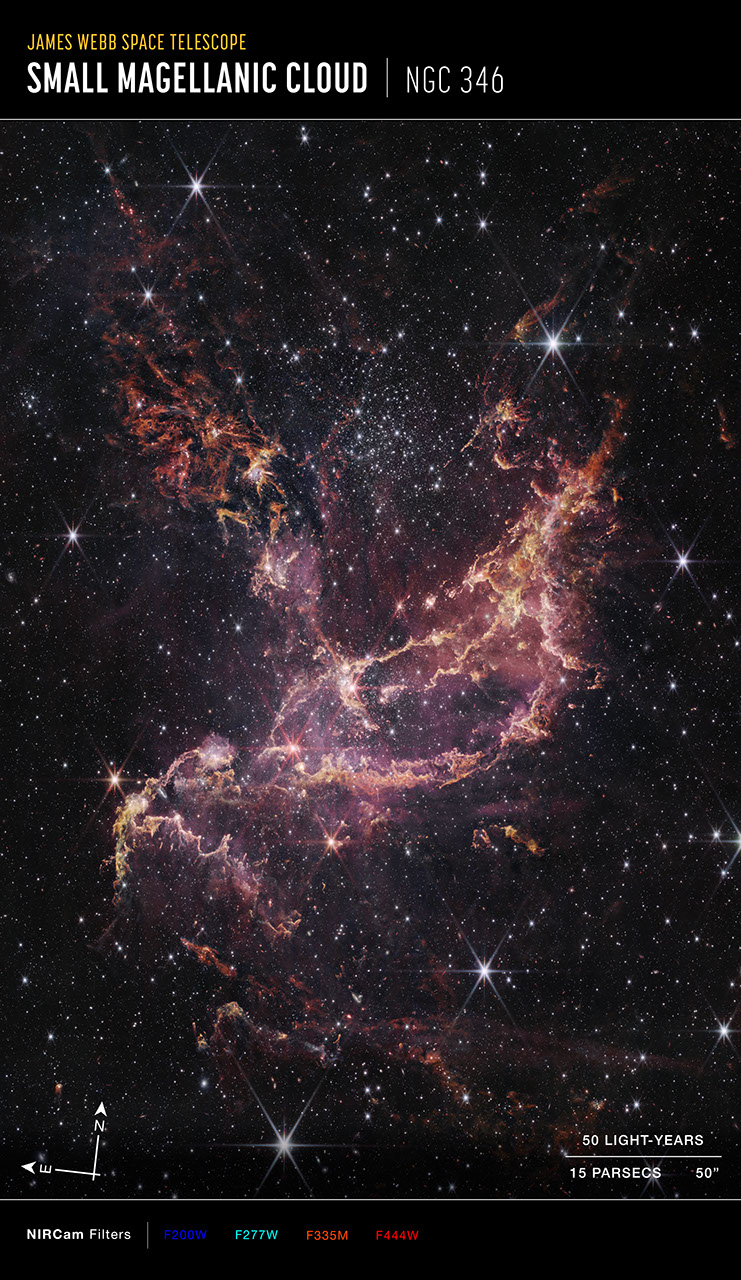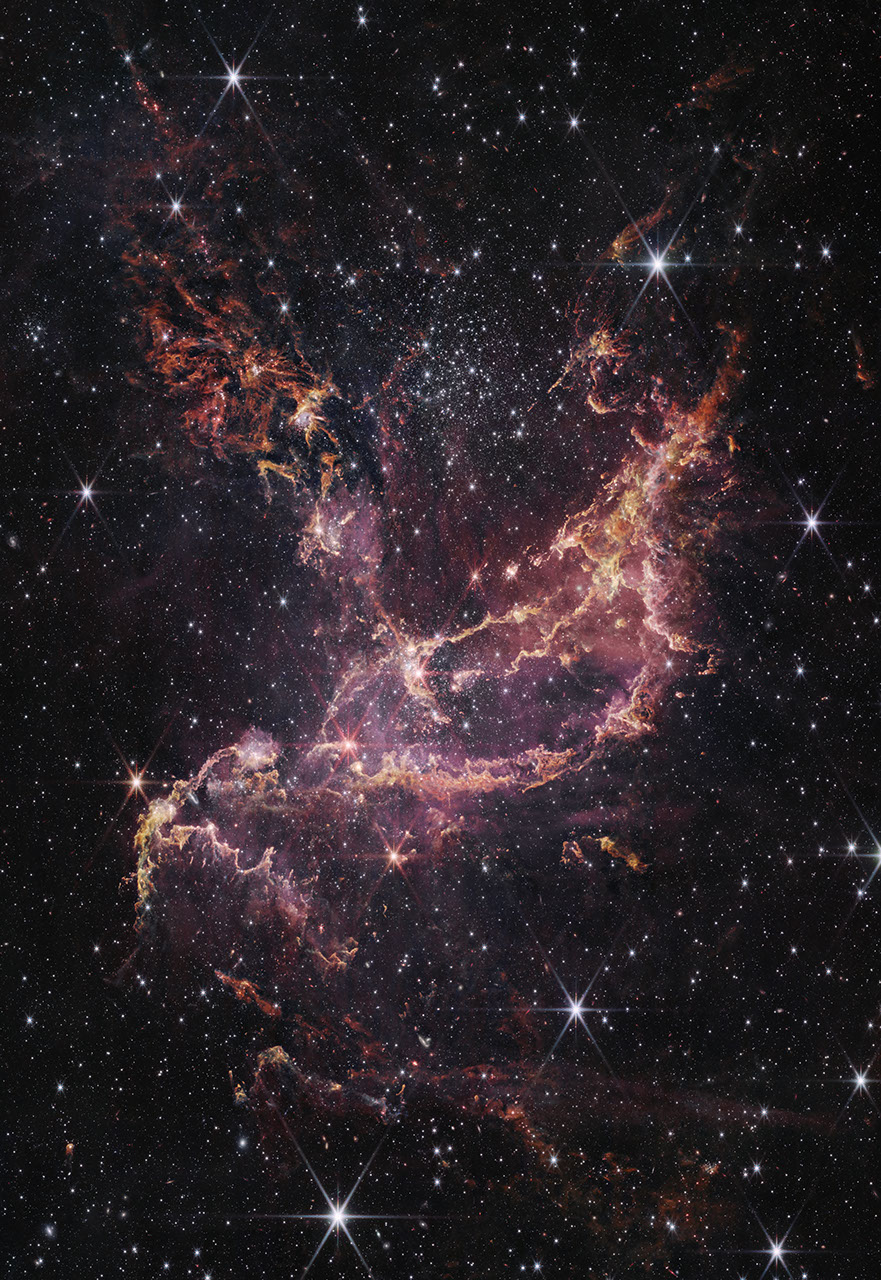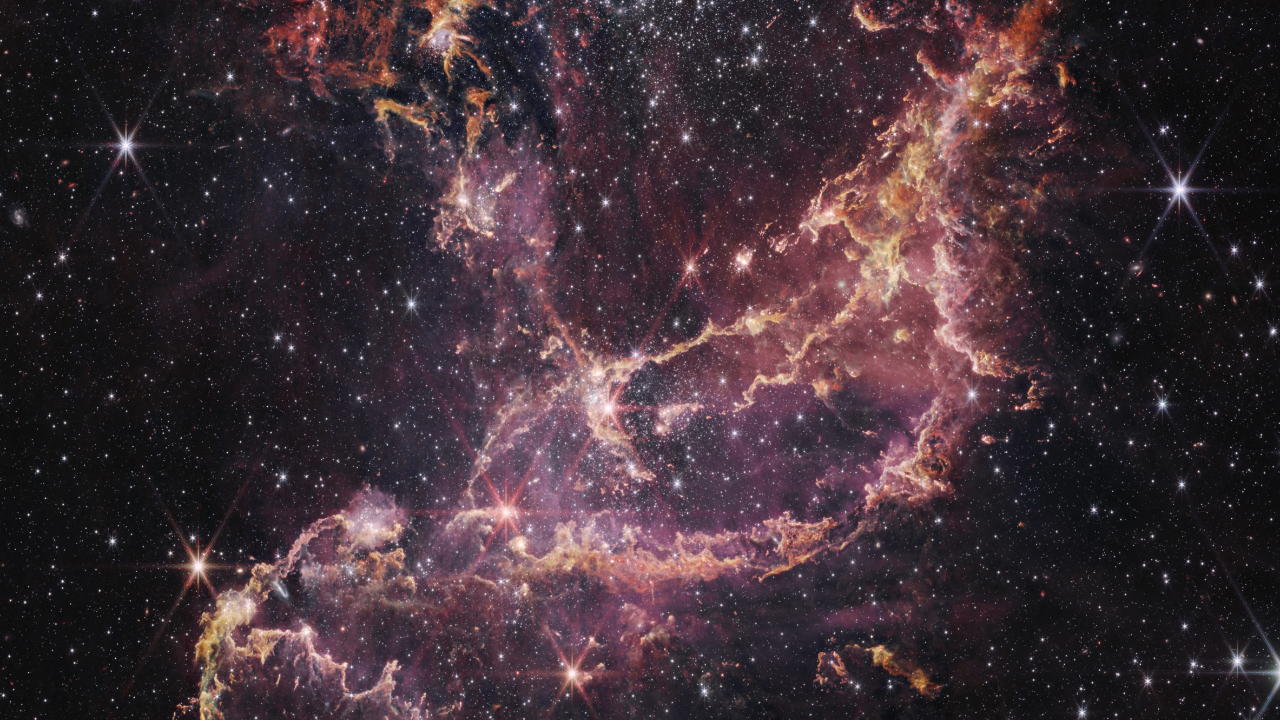1 min read
NGC 346 (NIRCam Compass Image)

This image of the star cluster NGC 346, captured by Webb’s Near-Infrared Camera (NIRCam), shows compass arrows, scale bar, and color key for reference.
The north and east compass arrows show the orientation of the image on the sky. Note that the relationship between north and east on the sky (as seen from below) is flipped relative to direction arrows on a map of the ground (as seen from above).
At the lower right is a scale bar labeled 50 light-years, 15 parsecs. The length of the scale bar is approximately one-fifth the total width of the image. Below the image is a color key showing which NIRCam filters were used to create the image and which visible-light color is assigned to each filter. From left to right, NIRCam filters are: F200W is blue; F277W is green; F335M is orange; and F444W is red.
About the Object
- R.A. PositionR.A. PositionRight ascension – analogous to longitude – is one component of an object's position.00:59:04.95
- Dec. PositionDec. PositionDeclination – analogous to latitude – is one component of an object's position.-72:10:09.15
- ConstellationConstellationOne of 88 recognized regions of the celestial sphere in which the object appears.Tucana
- DistanceDistanceThe physical distance from Earth to the astronomical object. Distances within our solar system are usually measured in Astronomical Units (AU). Distances between stars are usually measured in light-years. Interstellar distances can also be measured in parsecs.200,000 light-years away (61,300 parsecs)
- DimensionsDimensionsThe physical size of the object or the apparent angle it subtends on the sky.This image is about 3.9 arcminutes across (240 light-years).
About the Data
- Data DescriptionData DescriptionProposal: A description of the observations, their scientific justification, and the links to the data available in the science archive.
Science Team: The astronomers who planned the observations and analyzed the data. "PI" refers to the Principal Investigator.This image was created with Webb data from proposal: 1227 (M. Meixner).
- InstrumentInstrumentThe science instrument used to produce the data.NIRCam
- Exposure DatesExposure DatesThe date(s) that the telescope made its observations and the total exposure time.16 June 2022, 26 June 2022, 10 Oct 2022
- FiltersFiltersThe camera filters that were used in the science observations.F200W; F277W; F335M; F444W
- Object NameObject NameA name or catalog number that astronomers use to identify an astronomical object.NGC 346
- Object DescriptionObject DescriptionThe type of astronomical object.Cluster and Nebulosity in the Small Magellanic Cloud
- Release DateJanuary 11, 2023
- Science ReleaseNASA’s Webb Uncovers Star Formation in Cluster’s Dusty Ribbons
- CreditNASA, ESA, CSA, Olivia Jones (UK ATC), Guido De Marchi (ESTEC), Margaret Meixner (USRA); Image Processing: Alyssa Pagan (STScI), Nolan Habel (USRA), Laura Lenkić (USRA), Laurie Chu (NASA Ames)

These images are a composite of separate exposures acquired by the James Webb Space Telescope using the NIRCam instrument. Several filters were used to sample specific wavelength ranges. The color results from assigning different hues (colors) to each monochromatic (grayscale) image associated with an individual filter. In this case, the assigned colors are: Red: F444W, Orange: F335M, Cyan: F277W, Blue: F200W
Related Images & Videos

NGC 346 (NIRCam Image)
NGC 346, shown here in this image from NASA’s James Webb Space Telescope Near-Infrared Camera (NIRCam), is a dynamic star cluster that lies within a nebula 200,000 light years away. Webb reveals the presence of many more building blocks than previously expected, not only for...

Video Tour of NGC 346
This video tours areas of NGC 346, one of the most dynamic star-forming regions in nearby galaxies. NGC 346, a star cluster that lies within a nebula, is located 210,000 light years away. It resides within the Small Magellanic Cloud, a dwarf galaxy close to our Milky Way. New...
Share
Details
Laura Betz
NASA’s Goddard Space Flight Center
Greenbelt, Maryland
laura.e.betz@nasa.gov
NASA, ESA, CSA, Olivia Jones (UK ATC), Guido De Marchi (ESTEC), Margaret Meixner (USRA)
Alyssa Pagan (STScI), Nolan Habel (USRA), Laura Lenki? (USRA), Laurie Chu (NASA Ames)






























